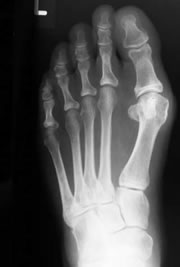What Is a Bunion and Who Develops Them?
 When you have a bunion, it looks like the joint at the base of the big toe has bulged out along the side of the foot. In that characteristic “bump,” you are actually seeing the effect of additional bone formation in the joint and a mechanical mis-alignment of the big toe (also called the great toe). A bunion causes the big toe to angle toward the smaller toes. This abnormal, and often painful, position is referred to as hallux valgus or hallux abducto valgus.
When you have a bunion, it looks like the joint at the base of the big toe has bulged out along the side of the foot. In that characteristic “bump,” you are actually seeing the effect of additional bone formation in the joint and a mechanical mis-alignment of the big toe (also called the great toe). A bunion causes the big toe to angle toward the smaller toes. This abnormal, and often painful, position is referred to as hallux valgus or hallux abducto valgus.
Although bunions affect women much more often than men, tight-fitting and high-heeled shoes are not the sole cause of bunions. Ill-fitting shoes may add to the problem, but some inherited factors may predispose certain people to the formation of bunions, including congenital abnormalities in bone formation, rheumatoid arthritis, nerve conditions and injury.
What Are the Symptoms of a Bunion?
Sometimes bunions cause no symptoms whatsoever, but most bunions cause intermittent (comes and goes) or chronic (persistent) pain at the base of the big toe. The pain may be worse when walking or wearing shoes, and it may feel better when resting. Very painful bunions may appear red and swollen, and feel tender to the touch.
In order to diagnose you properly, your doctor will consider your symptoms, examine your feet, and take X-rays to get a clear view of the alignment of your toes and the condition of the joints in your feet.
How Are Bunions Treated?
Your doctor may recommend different treatment options depending on your particular injury and symptoms.
Rest Up and Dress Right.
Resting your feet more often can go a long way toward alleviating the irritating pain of a bunion. Make sure the shoes you wear have a roomy toe box and a low heel so not to crowd the toes. Remember, well-fitting shoes will be comfortable from the start.
Manage the Pain.
Your doctor may prescribe or recommend the use of anti-inflammatory medications (like aspirin or ibuprofen) and cold packs that will help to reduce inflammation as well as the pain associated with your bunion. Sometimes a local injection of cortisone at the base of the big toe helps to further reduce inflammation.
Get the Right Support.
Orthotic devices sometimes help. A bunion splint worn at night or custom-made shoe insoles provide support, and may have the added benefit of helping to reposition the mis-aligned joint.
Understand Your Surgical Options.
If you are still experiencing bunion pain after all other conservative measures have been taken, your doctor may suggest surgery to help relieve your pain and restore your mobility. Bunion surgery often involves removing the unwanted bony growth and re-aligning the big toe. Today, a full range of surgical solutions are available that enable your doctor to customize the procedure to your particular needs and anatomy – whether you need joint support or surgery.
Be sure to talk with your doctor about the best treatment option for you.